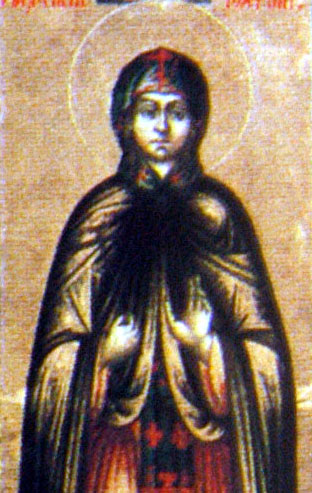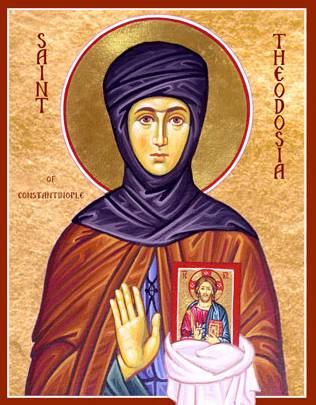Sainte Théodosie
moniale martyre à Constantinople (8ème s.)
À Constantinople, au VIIIe siècle, sainte Théodosie, moniale. Pour avoir pris la défense d’une antique image du Christ, que l’empereur Léon l’Isaurien avait ordonné de retirer de la Porte d’airain du palais impérial, elle subit le martyre.
Martyrologe romain
St. Theodosia of Constantinople
St. Theodosia of Constantinople lived during the eighth century and was born in answer to the fervent prayers of her parents. After their deaths, she was raised at the women’s monastery of the Holy Martyr Anastasia in Constantinople. After distributing what remained of her parental inheritance to the poor, she became a nun. She also used part of the money to commission gold and silver icons of the Savior, the Theotokos, and St. Anastasia.
When Leo the Isaurian ascended the throne, he issued an edict that holy icons be destroyed everywhere. Above the Bronze Gates at Constantinople was a bronze icon of the Savior, which had been there for more than 400 years. In 730, the iconoclast Patriarch Anastasius ordered that the icon be destroyed.
The Virgin Martyr Theodosia and other women rushed to protect the icon and toppled the ladder with the soldier who was carrying out the command. The women then stoned Patriarch Anastasius.
Emperor Leo ordered the women to be beheaded. St. Theodosia, an ardent defender of icons, was thrown in prison. She was given one hundred lashes a day for over one week. On the eighth day, she was led through the city, being beaten along the way. Ultimately, one of the soldiers stabbed her in the throat with a ram’s horn, and she received the crown of martyrdom.
Following the Triumph of Orthodoxy over iconoclasm she was recognized as a martyr and saint, and The body of the holy virgin martyr was reverently buried by Christians in the St. Euphemia Monastery in Constantinople, near a place called Dexiokratis. The tomb of St. Theodosia was glorified by numerous healings of the sick.
The Virgin Martyr Theodosia of Constantinople lived during the eighth century. She was born in answer to the fervent prayers of her parents. After their death, she was raised at the women’s monastery of the holy Martyr Anastasia in Constantinople. St Theodosia became a nun after she distributed to the poor of what remained of her parental inheritance. She used part of the money to commission gold and silver icons of the Savior, the Theotokos, and St Anastasia.
When Leo the Isaurian (717-741) ascended the imperial throne, he issued an edict to destroy holy icons everywhere. Above the Bronze Gates at Constantinople was a bronze icon of the Savior, which had been there for more than 400 years. In 730, the iconoclast Patriarch Anastasius ordered the icon removed.
The Virgin Martyr Theodosia and other women rushed to protect the icon and toppled the ladder with the soldier who was carrying out the command. Then they stoned the impious Patriarch Anastasius, and Emperor Leo ordered soldiers to behead the women. St Theodosia, an ardent defender of icons, was locked up in prison. For a week they gave her a hundred lashes each day. On the eighth day, they led her about the city, fiercely beating her along the way. One of the soldiers stabbed the nun in the throat with a ram’s horn, and she received the crown of martyrdom.
The body of the holy virgin martyr was reverently buried by Christians in the monastery of St Euphemia in Constantinople, near a place called Dexiokratis. The tomb of St Theodosia was glorified by numerous healings of the sick.
SOURCE : http://oca.org/saints/lives/2013/05/29/101564-virginmartyr-theodosia-the-nun-of-constantinople
St. Theodosia, Virginmartyr, of Constantinople
Commemorated on May 29
St. Theodosia of Constantinople lived during the eighth century and was born in answer to the fervent prayers of her parents. After their deaths, she was raised at the women’s monastery of the Holy Martyr Anastasia in Constantinople. After distributing what remained of her parental inheritance to the poor, she became a nun. She also used part of the money to commission gold and silver icons of the Savior, the Theotokos, and St. Anastasia.
When Leo the Isaurian ascended the throne, he issued an edict that holy icons be destroyed everywhere. Above the Bronze Gates at Constantinople was a bronze icon of the Savior, which had been there for more than 400 years. In 730, the iconoclast Patriarch Anastasius ordered that the icon be destroyed.
The Virgin Martyr Theodosia and other women rushed to protect the icon and toppled the ladder with the soldier who was carrying out the command. The women then stoned Patriarch Anastasius.
Emperor Leo ordered the women to be beheaded. St. Theodosia, an ardent defender of icons, was thrown in prison. She was given one hundred lashes a day for over one week. On the eighth day, she was led through the city, being beaten along the way. Ultimately, one of the soldiers stabbed her in the throat with a ram’s horn, and she received the crown of martyrdom.
The body of the holy virgin martyr was reverently buried by Christians in the St. Euphemia Monastery in Constantinople, near a place called Dexiokratis. The tomb of St. Theodosia was glorified by numerous healings of the sick.
Troparion, Tone 4:
Your lamb Theodosia, O Jesus,
Calls out to You in a loud voice:
I love You, O my bridegroom,
And in seeking You, I endure suffering.
In Baptism I was crucified so that I might reign in You,
And died so that I might live with You.
Accept me as a pure sacrifice,
For I have offered myself in love.
By her prayers save our souls, since You are merciful.
Kontakion, Tone 2:
Through your striving, O venerable Theodosia,
You inherited a life of peace.
By shedding your blood, you vanquished the enemy of the Church of Christ.
As you rejoice now in His presence, ever pray to Him for us all!
Kontakion, Tone 4:
You were betrothed to the King of Heaven
as a pure and trophy-bearing martyr.
Entreat Him to save our souls, praiseworthy Theodosia.
By permission of the Orthodox Church in America (www.oca.org)
SOURCE : http://www.antiochian.org/node/18652

